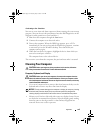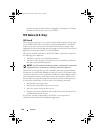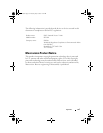
160 Glossary
battery — A rechargeable internal power source used to operate portable computers
when not connected to an AC adapter and an electrical outlet.
battery life span — The length of time (years) during which a portable computer
battery is able to be depleted and recharged.
battery operating time — The length of time (minutes or hours) that a portable
computer battery holds a charge while powering the computer.
BIOS — basic input/output system — A program (or utility) that serves as an
interface between the computer hardware and the operating system. Unless you
understand what effect these settings have on the computer, do not change them. Also
referred to as the system setup program.
bit — The smallest unit of data interpreted by your computer.
boot sequence — Specifies the order of the devices from which the computer
attempts to boot.
bootable CD — A CD that you can use to start your computer. In case your hard drive
is damaged or your computer has a virus, ensure that you always have a bootable CD
or floppy disk available. Your Drivers and Utilities media is a bootable CD.
bootable disk — A disk that you can use to start your computer. In case your hard
drive is damaged or your computer has a virus, ensure that you always have a bootable
CD or floppy disk available.
bps — bits per second — The standard unit for measuring data transmission speed.
BTU — British thermal unit — A measurement of heat output.
bus — A communication pathway between the components in your computer.
bus speed — The speed, given in MHz, that indicates how fast a bus can transfer
information.
byte — The basic data unit used by your computer. A byte is usually equal to 8 bits.
C
C — Celsius — A temperature measurement scale where 0° is the freezing point and
100° is the boiling point of water.
cache — A special high-speed storage mechanism which can be either a reserved
section of main memory or an independent high-speed storage device. The cache
enhances the efficiency of many processor operations.
L1 cache — Primary cache stored inside the processor.
L2 cache — Secondary cache which can either be external to the processor or
incorporated into the processor architecture.
book.book Page 160 Tuesday, July 3, 2007 12:31 PM


















